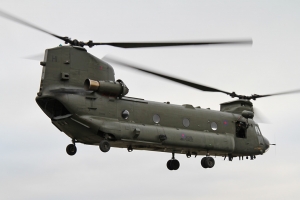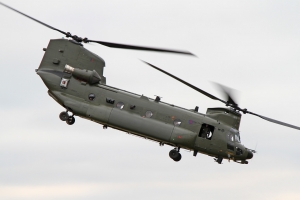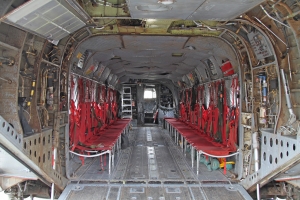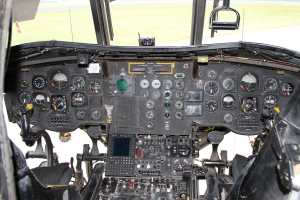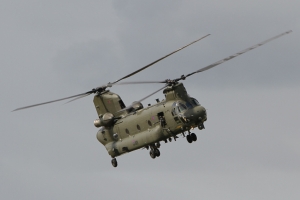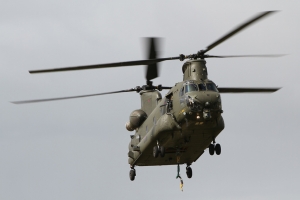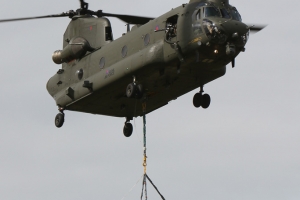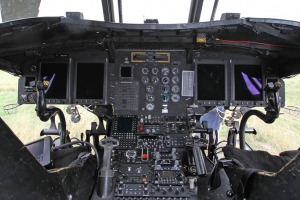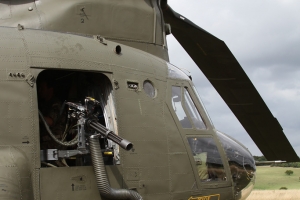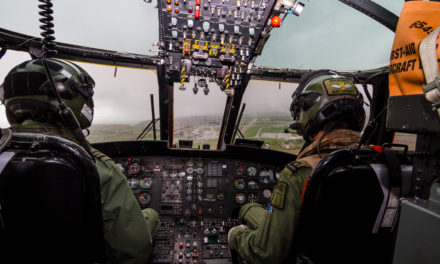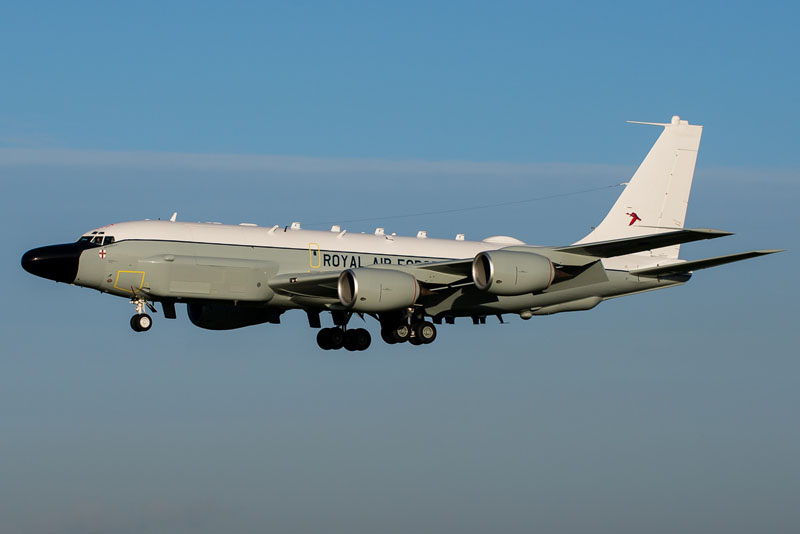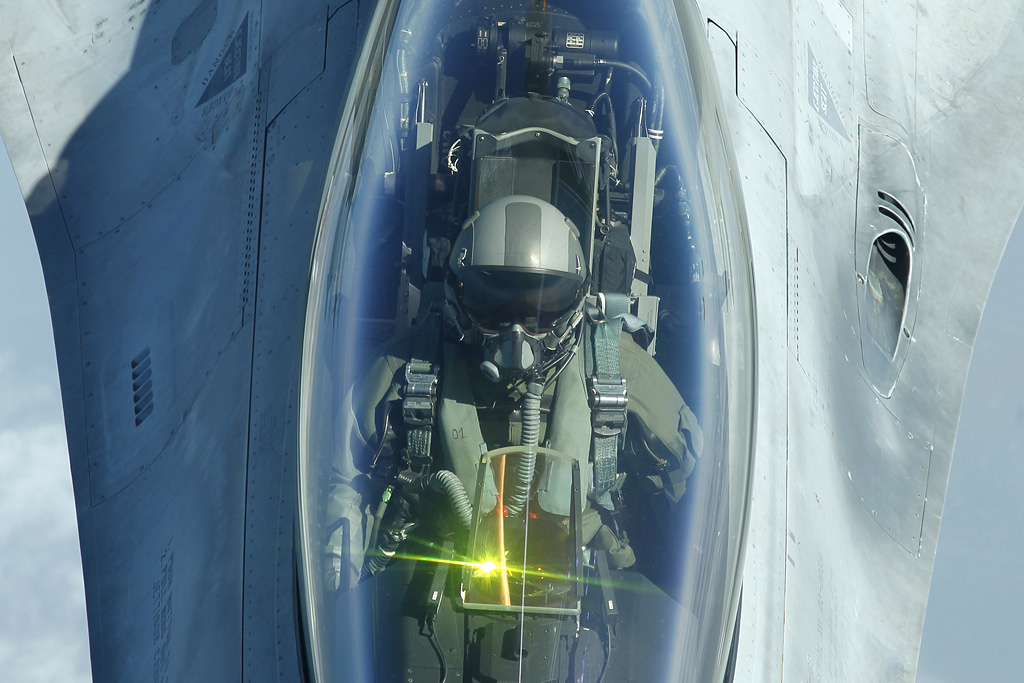As operations in Afghanistan continue towards a complete withdrawal by the end of 2014, Chris Wood reports from Salisbury Plain on the RAF’s latest addition to the campaign, the recently modified Chinook HC4.
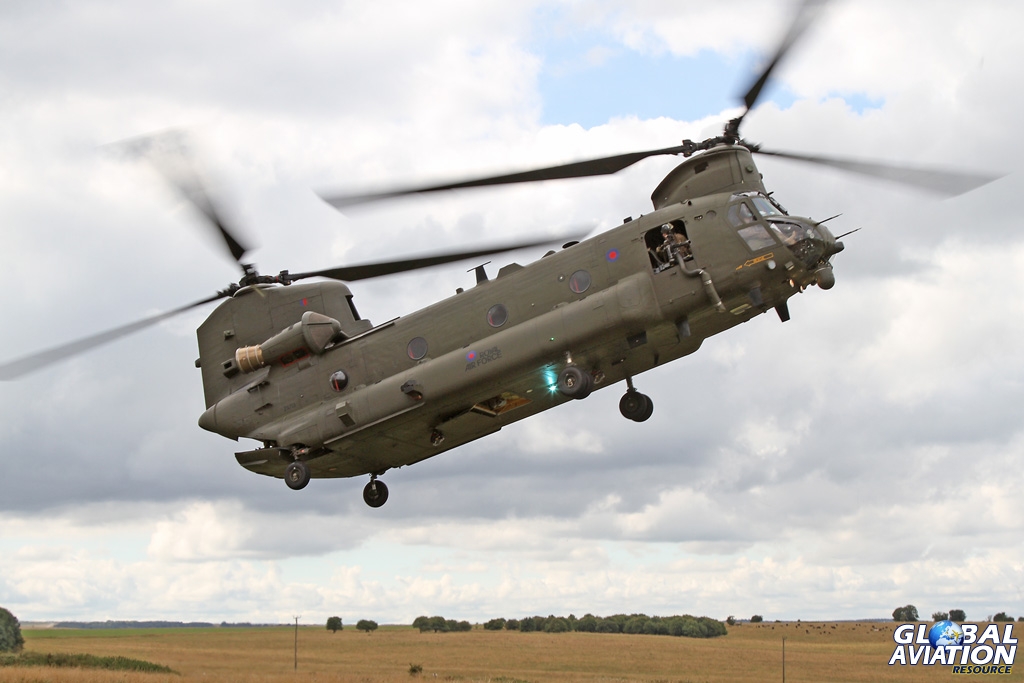
Chinook HC4 © Chris Wood – www.globalaviationresource.com
Britain’s Royal Air Force has been operating the Boeing Chinook since December 1980, when the first of the initial batch of 33 Chinook HC1s (equivalent to the US Army’s CH-47C model) entered service with the Chinook Flight of No. 240 Operational Conversion Unit (OCU) at RAF Odiham in Hampshire. Front line service started in August 1981 with No. 18 Squadron followed by No. 7 Squadron in 1982. In 1986, No. 78 Squadron was reformed to operate Chinooks and Sea Kings in the Falkland Islands, however, it re-equipped with the Merlin and moved to RAF Benson in December 2007. In 1993 the OCU became No. 27 (Reserve) Squadron, regaining full Squadron status in 1998, and Nos. 7, 18 and 27 Squadrons form today’s Chinook force, all based at RAF Odiham.
Another eight HC1s were added to the fleet between 1984 and 1986, with all the survivors being modified to HC2 standard (equivalent to the CH-47D model) by Boeing. The first aircraft arrived back in the UK in 1993. An additional three HC2s were ordered, with deliveries starting in 1995, whilst a further 14 were ordered that year. These featured a strengthened forward fuselage to allow for the fitting of an in flight refuelling probe, and were designated as HC2As.
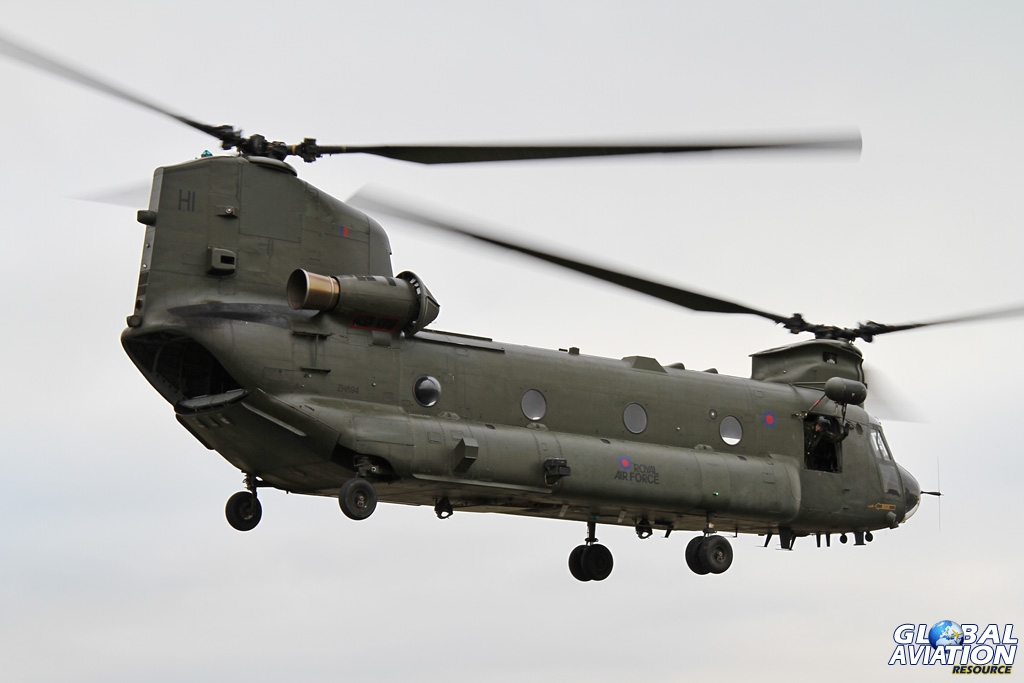
Chinook HC2A © Chris Wood – www.globalaviationresource.com
Six aircraft were delivered as HC2As but the remaining eight aircraft were modified for Special Forces operations with bigger fuel tanks, night vision sensors and improved navigation equipment. These were designated as HC3s (similar to the US Army’s MH-47E) but, despite being delivered in 2001, didn’t enter service until 2010 following contractual issues which is another, well documented, story.
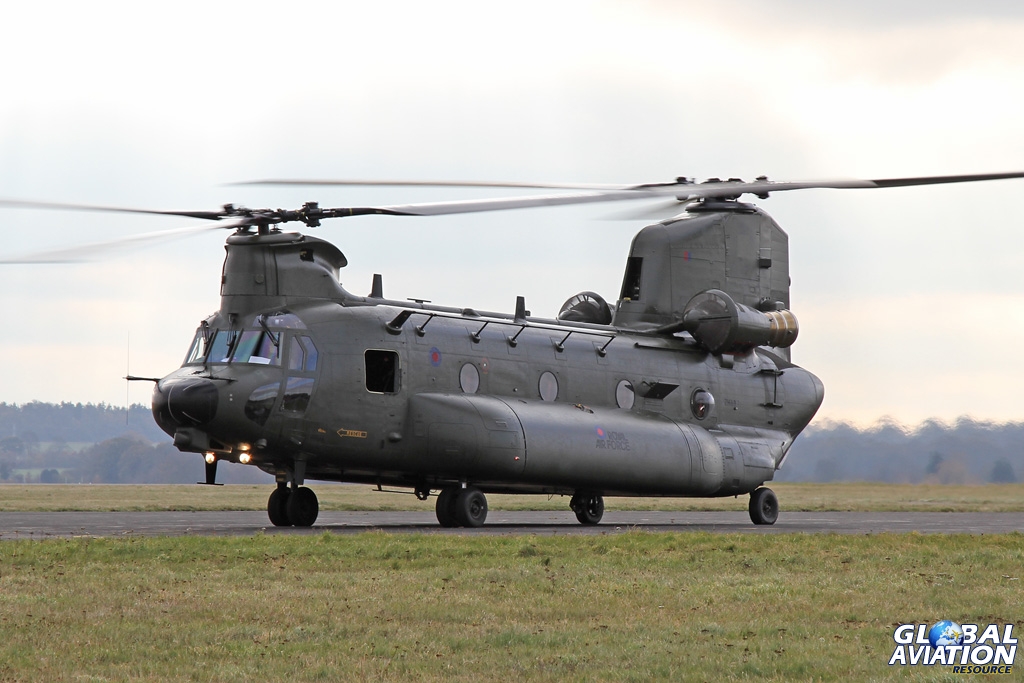
Chinook HC3 © Chris Wood – www.globalaviationresource.com
As a result of the issues surrounding the HC3s, in 2002 eight HC2 aircraft operated by No. 7 Squadron, which by that time had become part of the Joint Special Forces Air Wing, were modified with the Night Enhancement Package (NEP) to enable them to operate in very low light conditions. This included a thermal imaging capability with the fitment of a Forward Looking Infra Red (FLIR) turret, an enhanced navigation suite with Inertial Navigation System (INS), Global Positioning System (GPS) and moving map displays plus Night Vision Goggle (NVG) compatibility. This was very much a stopgap measure, and the cockpit ergonomics of the NEP aircraft were less than ideal with additional display screens attached in positions outside the pilot’s normal instrument flying scan.

Chinook HC2 with NEP © Chris Wood – www.globalaviationresource.com
Currently the operational fleet stands at 46 aircraft, with 12 having been lost in action or in accidents, although three of these are in use as Ground Instructional Airframes. Due to the number of upgrades and modifications that have taken place over the last 30 years, there were a large number of differences between individual aircraft (it has been reported that there were 17 different equipment fits!) Consequently a major modification programme has been instigated for the whole fleet to bring all the aircraft to the same standard and a lot of money has being invested to achieve this. After modification, the HC2s and HC2As will become HC4s and HC4As, whilst the HC3s will become HC5s.
According to Captain Dave Childs RN, the current Chinook Project Team Leader (PTL) at Defence Equipment and Support (DE&S), the aim of the upgrade programme is to make all the aircraft as similar as possible, so that “any pilot can fly any Chinook on any mission.“ Speaking at the recent Operation HERRICK media briefing, he did concede, however, that they weren’t there yet.
Engine upgrades started in 2010, with the Honeywell (formerly Lycoming) T55-L-712 engines being replaced by the uprated 4,777 shp L-714A model. According to the manufacturer, the -714A provides around 17% more power for a 5% lower fuel burn than earlier engine models, which will be particularly beneficial in hot and high environments such as Afghanistan.
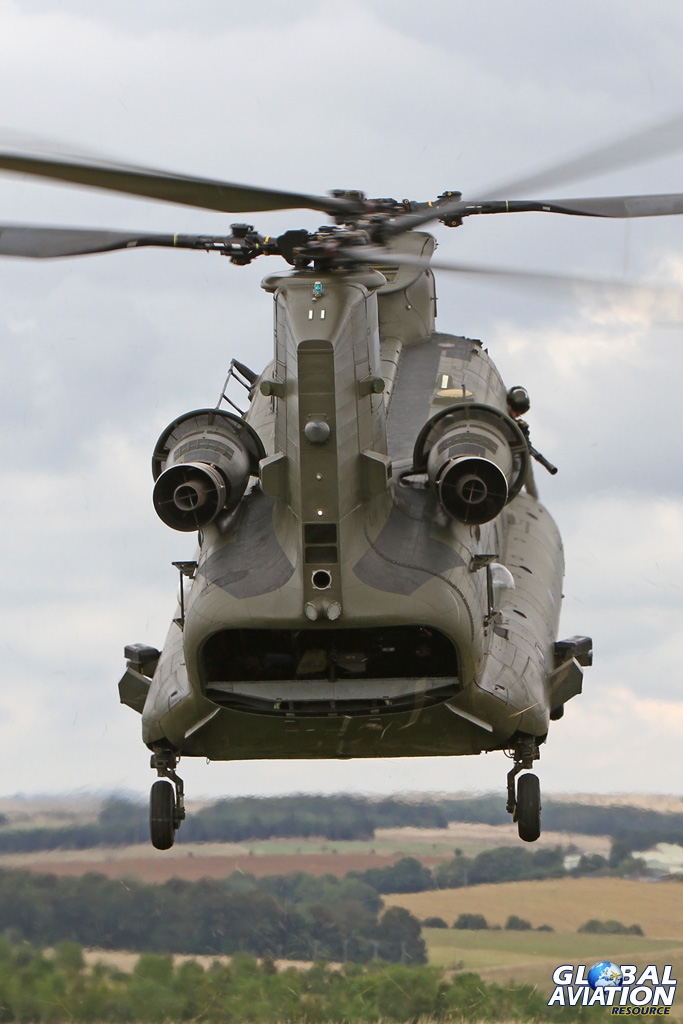
© Chris Wood – www.globalaviationresource.com
Other upgrades include Project Baker, which sees updates to the aircraft’s Selex ES (formerly Selex Galileo) integrated Defensive Aids System (DAS), and Project Benic, which updates the communications suite.
However, the biggest and most expensive upgrade is to the cockpit under Project Julius. This sees the aircraft being fitted with the Thales Top Deck cockpit, featuring four multi-function displays (MFDs) and two standby flight displays. Whilst the actual MFDs weren’t shown powered up, it would seem that the outer two screens normally display the flight instruments (similar to a Primary Flight Display (PFD) in commercial aircraft), whilst the inner two screens are normally used to provide a Navigation Display (ND), or for tactical information such as images from the Selex ES Titan 385ES-HD (enhanced stability – high definition) FLIR turret and a moving map display. It would seem that tactical information can also be displayed on the outer screens, whilst the standby flight displays provide a back-up source of flight instruments. Providing the information for the flight instruments are a pair of new air data computers. It is not, however, a full “glass cockpit” as the centre instrument panel, containing the engine and transmission instruments, is still analogue.

HC2 cockpit © Chris Wood – www.globalaviationresource.com
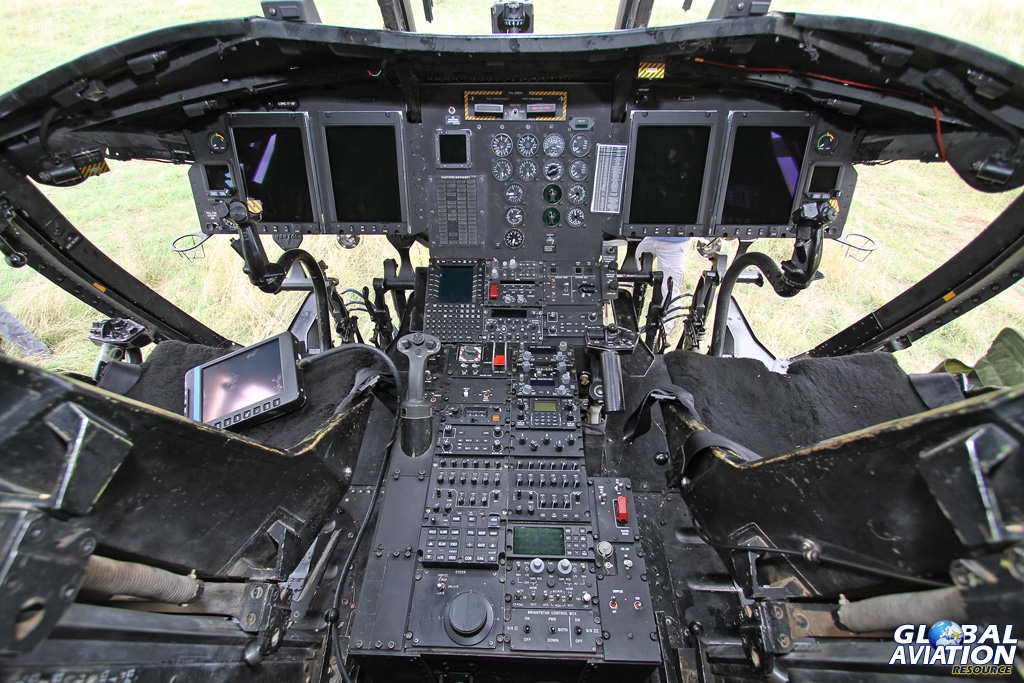
HC4 cockpit © Chris Wood – www.globalaviationresource.com
There is also a tablet-based computer for mission planning and management for the pilots, and also for the rear crew which is mounted at the forward crewman’s station. This also features a new seat.
For defence, the aircraft can be fitted with the same weapons as the other Chinook variants; a pair of six-barrelled M134 Miniguns, normally mounted at the forward doors, and an M60D machine gun on the rear ramp. These are operated by the Loadmasters, who have recently been issued with full face helmets for extra protection.

M134 Minigun © Chris Wood – www.globalaviationresource.com

M60D machine gun © Chris Wood – www.globalaviationresource.com
Boeing is the primary contractor for the Project Julius upgrade programme, but the work is being carried out by Vector Aerospace at its Fleetlands facility at Gosport in Hampshire. The initial contract for eight aircraft was signed in December 2008 with the first flight of an HC4 aircraft, ZA677, occurring on 9 December 2010.
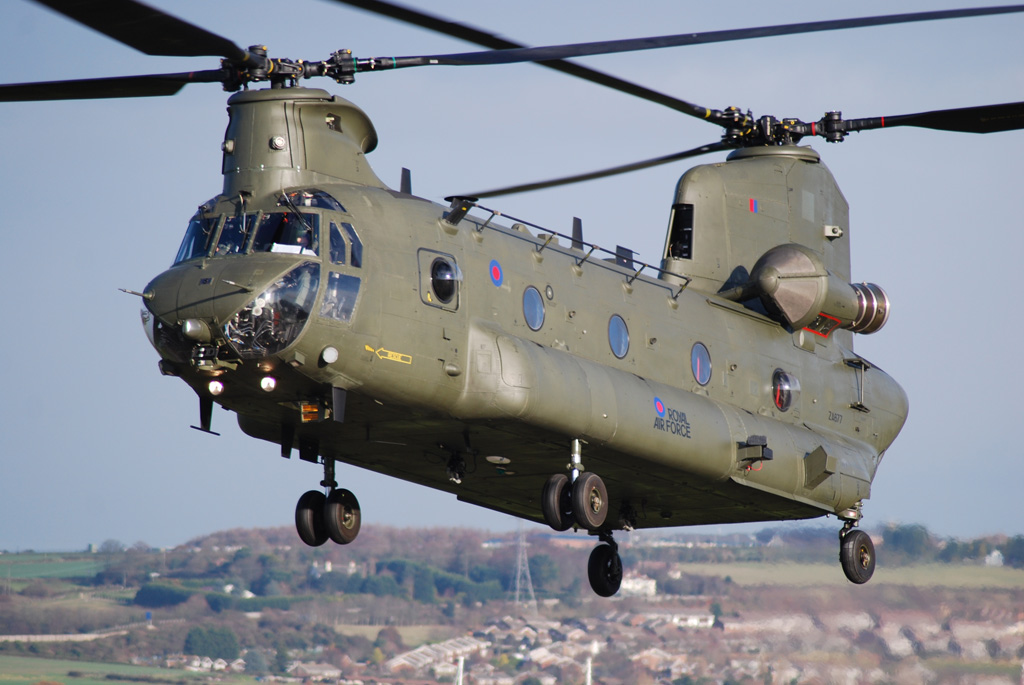
Chinook HC4 first flight © Vector Aerospace via Boeing
The Release to Service (RTS) was achieved on 11 May 2012 and Initial Operating Capability was declared on 15 June, which allowed the aircraft to be used in support of operations to protect the London Olympic Games in August. This was followed by the HC4’s first deployment to Afghanistan in December that year.
With the Chinook committed to operations in Afghanistan, part of the challenge of upgrading the aircraft was to avoid having any impact on the fleet’s operational tasking, and this has been achieved. When the modification work started it was taking around 160 days per aircraft, but, as the experience level has increased, this has decreased to 122 days. 16 aircraft had been converted by the end of August, there are five aircraft undergoing modification at any one time, and it is anticipated that the entire HC2 fleet will be completed by early 2015. They will be followed by the HC2As later in 2015 and the HC3s in 2016. The HC3s have a different airframe with larger fuel tanks and different flying characteristics, so will require a separate flight test programme.
Training the crews to operate the HC4 is relatively quick; the aircraft flies the same way, the major differences being how information is displayed and how much information is available. According to Gp Capt Dom Toriati, Station Commander at RAF Odiham, the complete training package took six weeks initially but as they’ve gained experience with the aircraft this has been reduced to three weeks.
However, the HC4 isn’t the end of the RAFs Chinook story. In 2009 an additional 24 Chinooks were ordered, although this was later reduced to twelve new aircraft and two attrition replacements, a total of 14. These will be the HC6 version, which is based on the US Army’s CH-47F model. This features a monolithic airframe which is high-speed machined rather than having the riveted panels of the earlier version. This has significantly reduced the number of parts by around 50%, and is stronger. The HC6 has the CH-47F airframe, but is fitted with the Project Julius Top Deck digital cockpit, a BAE Systems Digital Advanced Flight Control System (DAFCS), the Titan 385ES-HD FLIR turret and UK mission equipment such as Display Night Vision goggles (DNVG), a rescue hoist and the COBRA fire suppression system.
According to Flt Lt Steve Badham, who has flown the new aircraft, the DAFCS is a major improvement which will enable crews to perform automatic approaches to the hover, as well as providing an automatic hover capability. This will allow vertical landings in brownout, whiteout and foggy conditions, something which the current equipment fit does not allow, as neither FLIR nor NVG can “see” through dust and moisture. Presently the crews have to perform a running landing, keeping ahead of the cloud of dust or snow, which can be hazardous if there are obstructions in the landing zone. The Chinook does have frangible landing gear, which is designed to shear off rather than damage the airframe, but this is not an ideal option!

Chinook HC6 © Boeing
At the time of writing, the first three HC6s are taking part in a combined flight test programme, which involves Boeing and UK test pilots from Boscombe Down flying together. This will speed up the airworthiness certification of the aircraft, the first of which is expected to be delivered to the RAF before the end of 2013. They are planned to enter service in mid 2014, be ready for operational deployment in early 2015 and all 14 should be fully operational by early 2017.
The US Army is bringing large numbers of its fleet of CH-47D aircraft (virtually all of which are rebuilds of earlier A, B and C models) up to CH-47F standard as well as acquiring a smaller number of new build Fs, so it will be interesting to see if the RAF will follow its lead and continue to upgrade its own aircraft to HC6 standard, and beyond. There is no doubt that the addition of the DAFCS would make a significant improvement to its capabilities in theatres such as Afghanistan.
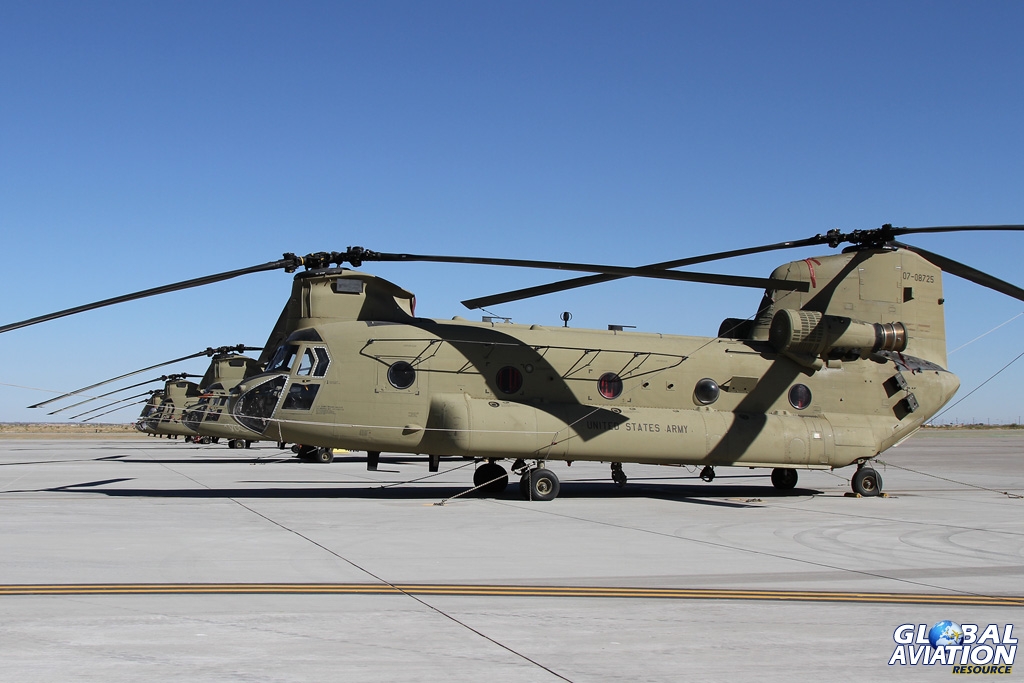
New build US Army CH-47F © Chris Wood – www.globalaviationresource.com
The RAF’s Chinooks have been on active service since the Falklands campaign of 1982. With the operations in Afghanistan winding down, it’s possible that the fleet may get a respite for once, unless of course another hot spot flares up and the Chinook’s unique capabilities are needed once again. One thing that does appear certain, though, is that despite already achieving over 30 years of service, the RAF’s Chinooks will be around for many more to come.


